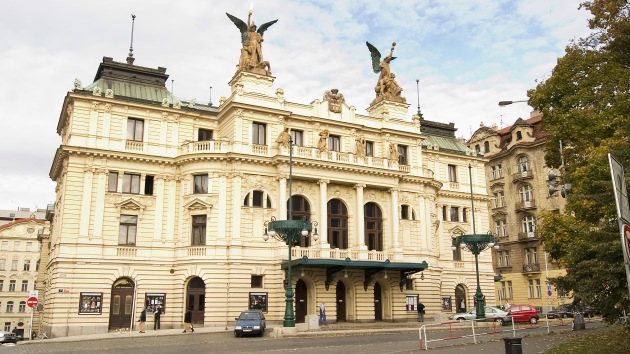
The Vinohrady Theatre is located on Peace Square close to the Church of St Ludmila and the National House Vinohrady. The theatre has borne this name since 1966.
The construction of the stone Vinohrady Theatre was preceded by many theatre companies operating on wooden stages. At the same time it was meant to be, after the National Theatre, the second stage where productions would be performed in Czech. For the construction of the theatre, the Vinohrady Union bought the Eichmanka Garden, which was donated by the city. In 1902 the tender was won by architect Alois Čenský. Although his original proposal was for a neo-Renaissance building, he eventually chose the Art Nouveau style.
The construction of the theatre lasted from 1905 to 1907 under the leadership of Jan Majer and Josef Vesely. The sculptural decoration of facades was the work of Milan Havlíček, and the sculptures on the terrace of the second floor were created by Bohumil Kafka (four allegories of Tragedy, Ballet, Opera and Comedy). Other decorations were created by sculptors Antonín Popp and Antonín Mara. The paintings in the theatre were made by František Urban, who painted the ceiling in the theme of homage to the nation's art. The curtain is the work of Vladimir Županský, but it was taken down in the 1950s and placed in the depository of the municipal museum.
The inauguration took place in 1907 to the sound of Smetana's Vltava. Scenes by Viktor Dyk and Lothar Suchy were played as well as the legend of Godiva by Jaroslav Vrchlický. The theatre had permanent drama and opera ensembles.
The theatre was made famous during the First Republic mainly thanks to director and playwright Karel Hugo Hilar. In 1922, the theatre underwent a modernization and soon a new circular stage, lighting and a mobile portal. A few years later the stage, orchestra pit and iron curtain were reconstructed. The theatre had 1,060 seats, 48 seats in the loges and 180 standing places.
The great hall on the first floor contains busts of artists who were closely connected to the Vinohrady Theatre. Particularly noteworthy is the bust of Karel Čapek by sculptor Karel Dvořák, given to the theatre by Olga Scheinpflugová. Then there are the busts of František Langer and Jiří Frejka created by Jan Kodet. The bust of actress Anna Letenská commemorates her heroic deed when she and her husband provided refuge to the persecuted in connection with the Heydrich assassination, for which she was subsequently executed.
During the Nazi occupation from 1941 to 1942 the theatre was closed, and in 1945 it was hit during an Allied air raid and damaged, just like the building of the Old Town Hall.
Interesting fact:
On the main facade a monumental allegory of Bravery and Truth by the sculptor Havlíček can be found on the mounted pylons. It was then probably the largest sculptures placed on the facade. They measured at a height of 7 m and together weighed 36 tons, but in 1994 were replaced by copies, because their condition was becoming critical.
It is possible, however, that these were already copies of copies, because the original statues were already in poor condition in 1938, and may have been replaced with copies from artificial stone by restorer Rudolf Vlach.








